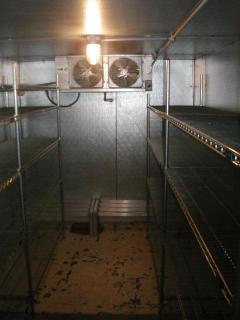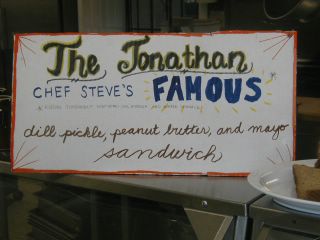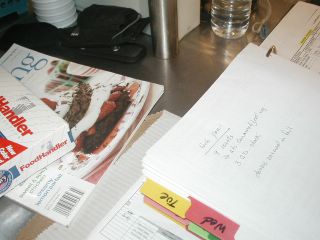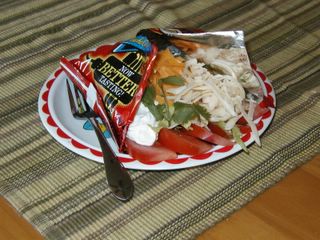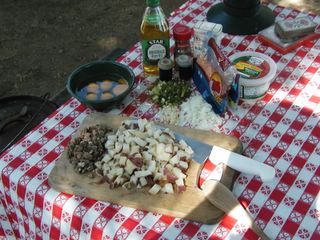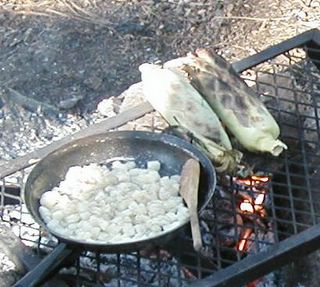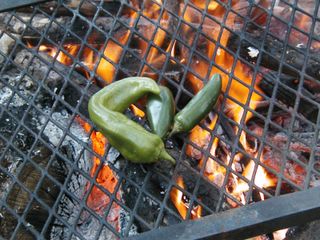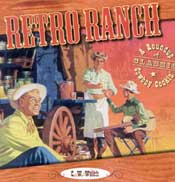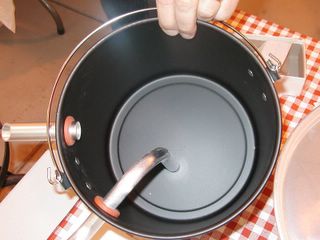A couple weeks ago I received this comment on 'Round the Chuckbox:
I was looking at the portion size for the mountain man breakfast. When I am out there are only 2 of us. The recipe serves 12 to 18. How do you cut it down to cover just 2? Like 1/2 green pepper if you cut it down in portion size you would get about one strip of pepper and if you didn't cut it down it would over power. This is the same on a lot of dishes. How do you cut things down and get the same taste? Hutch.
I'll be faced with the same problem soon. My family will be down to two in a few years. With both daughters out of the house, often my son and I are often the only ones camping. My wife usually joins us on longer trips.
Like you, I'm going to have to adjust my thinking on many camp recipes. At home I can prepare large recipes. This gives me leftovers to take to work during the week. But camp is not the place to be saddled with huge quantities of leftovers.
My approach to adjusting recipes in camp
I'd say approach the problem from two angles: First, attempt to cut the recipe in half. If that's still too much food, quarter the recipe. Many recipes--especially those with ingredients like eggs--can't be reduced much below one-fourth.
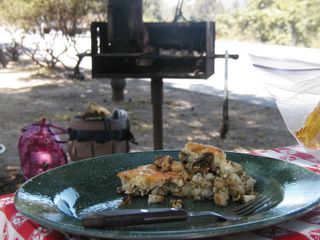 |
| Mountain man breakfast from leftovers. |
If that doesn't work (and it looks like you're already contemplated such a reduction), use your cooking senses and create a new recipe based on standard quantities of the main ingredients.
The way I look at this problem is this: Each person normally eats one to two eggs, a half-cup of hash browns and a sausage patty or two. That's what you're looking for in a single mountain man breakfast. Add a few tablespoons of onion and bell pepper (or hot peppers) and some shredded cheese and you've made a one-pot breakfast.
The instructions remain the same for two servings as for 18 with two or three notable exceptions. The only thing left to do is select the appropriate Dutch oven (a 5- or 8-inch oven) and adjust the number of charcoal briquettes for the smaller oven. You may need to reduce the baking time as well.
And don't forget to experiment and adjust ingredient quantities to your personal tastes. Mountain man breakfast is forgiving. It'll take abuse and come out good every time.
If you enjoy red and green bell peppers, add more. One or two tablespoons of finely chopped aromatics (onion, garlic and/or sweet and hot peppers) should be enough to add a flavor foundation to the breakfast.
Ingredients for the mountain man breakfast from leftovers.
And don't forget the leftovers that seem to pile up in camp. This morning I took leftover baked potatoes and London broil to form the foundation of a mountain man breakfast. Since I had five to feed, I baked the dish in a 10-inch Dutch oven. I added the eggs that were left in the cooler, chopped onions from last night's stroganoff (coming soon) and the remnants of a package of shredded cheese.
MOUNTAIN MAN BREAKFAST FROM LEFTOVERS
Use this recipe to give you ideas for preparing mountain man breakfast from leftovers. Mountain man breakfast is akin to hash, the ultimate in dishes created from leftovers. Quantities are approximate--add and take away ingredients to suit your tastes.
2 cloves garlic, minced
1/2 cup chopped onion
3 green onions, thinly sliced
2 tablespoons olive oil
2 medium red baked potatoes, diced small
2 ounces leftover beef steak, diced small
1 teaspoon Italian seasoning
Salt and pepper, to taste
5 eggs, lightly mixed
1/4 cup shredded Parmesan cheese
3/4 cup shredded cheddar cheese
Saute onions and garlic in olive oil over medium heat in 10-inch Dutch oven. Add potatoes and beef and stir to mix. Cook potato mixture for 5 to 10 minutes to develop some color. Season potato mixture with Italian seasoning, salt and pepper.
Pour eggs evenly over potato mixture. Add cheese to the top of the potato-eggs mixture and place lid on Dutch oven. Bake 20 to 30 minutes with 6 coals under and 14 coals on lid, until knife inserted in center of mixture comes out clean
Serve with your favorite marinara sauce or catsup. Serves 2 hearty or 4 to 6 lighter portions.
Note: This dish baked more like a fritata as it was only about one inch thick in the 10-inch oven. It should work in an 8-inch oven as well.
 |
| When I saw the steller's jay land on the charcoal chimney, my first thought was, "What a dumb bird!" After all, I thought the coals had been burning for 20 minutes. This guy should've toasted his feet. Needless to say, I had to relight the charcoal ... |



